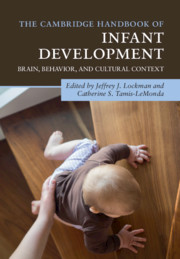Book contents
- The Cambridge Handbook of Infant Development
- The Cambridge Handbook of Infant Development
- Copyright page
- Dedication
- Contents
- Illustrations
- Contributors
- Preface
- Part I Foundations
- Part II Perceptual Development
- 6 Visual Development
- 7 Infant Visual Attention
- 8 Infants’ Perception of Auditory Patterns
- 9 The Development of Touch Perception and Body Representation
- 10 The Development of Infant Feeding
- 11 The Development of Multisensory Attention Skills
- Part III Cognitive Development
- Part IV Action
- Part V Language
- Part VI Emotional and Social Development
- Index
- References
8 - Infants’ Perception of Auditory Patterns
from Part II - Perceptual Development
Published online by Cambridge University Press: 26 September 2020
- The Cambridge Handbook of Infant Development
- The Cambridge Handbook of Infant Development
- Copyright page
- Dedication
- Contents
- Illustrations
- Contributors
- Preface
- Part I Foundations
- Part II Perceptual Development
- 6 Visual Development
- 7 Infant Visual Attention
- 8 Infants’ Perception of Auditory Patterns
- 9 The Development of Touch Perception and Body Representation
- 10 The Development of Infant Feeding
- 11 The Development of Multisensory Attention Skills
- Part III Cognitive Development
- Part IV Action
- Part V Language
- Part VI Emotional and Social Development
- Index
- References
Summary
Unlike visual patterns, which are typically distributed in space, auditory patterns are necessarily distributed in time. As a result, listeners must allocate their attention over time, implicating memory processes as they track global as well as local features of patterns. Because of the cognitive and experiential limitations of infants, one might expect their perception of auditory patterns to differ drastically from that of adults. There are notable adult–infant differences, of course, but there are also parallels, which stem largely from infants’ holistic approach to auditory pattern processing and their biological predispositions.
Keywords
- Type
- Chapter
- Information
- The Cambridge Handbook of Infant DevelopmentBrain, Behavior, and Cultural Context, pp. 214 - 237Publisher: Cambridge University PressPrint publication year: 2020
References
- 1
- Cited by



